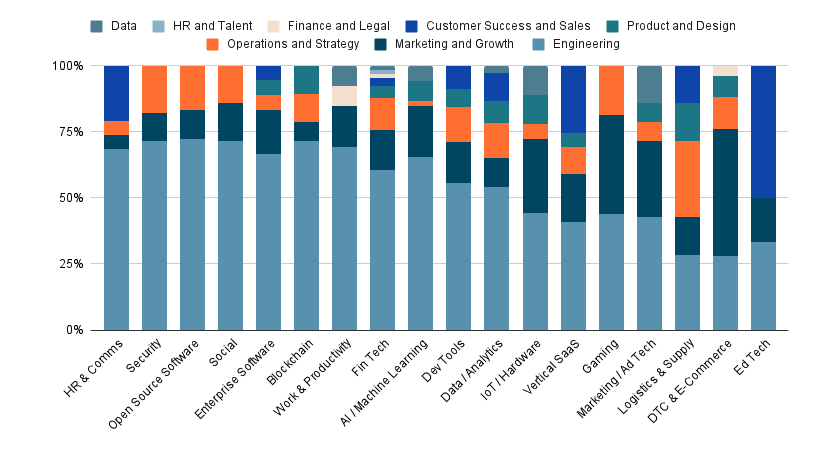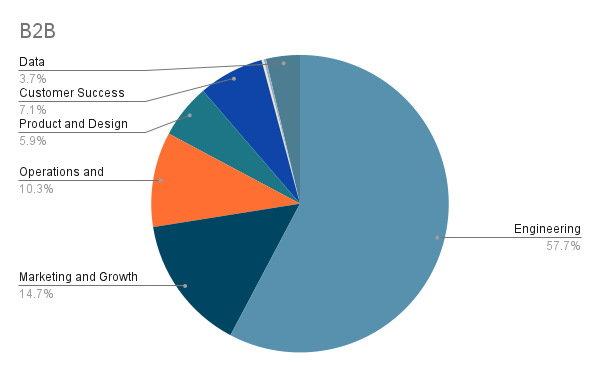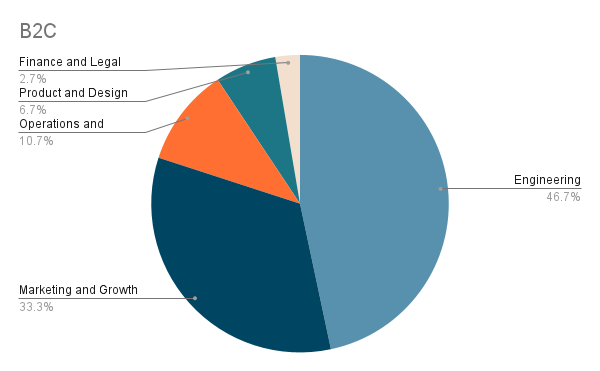Hiring the right people is one of the most important components of company-building, especially at the earliest stages. However, deciding who to hire and which roles to prioritise is easier said than done.
In this piece, we have mapped out the hiring decisions made by 60 Seedcamp-backed companies with less than 20 employees. These companies are all pre-Series A and although the dataset doesn’t spit out any ‘right answers’ about who to hire, it surfaces lots of interesting correlations.
Inspired by Lenny Rachitsky’s article about the order of early hires at breakout B2B companies, we tackle hiring from a different angle, focusing on the hiring patterns driven by sector and distribution channel.

Engineering is the most important role among the first 20 hires by a significant distance. Across most sectors, engineers comprise over 50% of the first 20 hires and in several sectors, engineers comprise closer to 75%. In categories with a lower engineering contingent, such as Gaming, E-Commerce and Ed Tech, design and marketing functions tend to eat into engineering as a result of the intense competition for eyeballs on the end-user experience.
Data hires are most obviously critical for cases where the core product involves interaction with company or user data (e.g. ad tech, ML, AI). Data engineers also tend to be more important for companies where product-market-fit can be an exercise in fine margins (e.g. enterprise, productivity). Understanding user interactions with the product and making minute adjustments to UX choices can unlock big retention gains.
Customer Success and Sales hiring seems to depend more on the typical sales cycle for the product. Highly complex deals with large enterprise customers require a sales-led motion and strong post-sales support. Whereas security and OSS (open source software) tools don’t necessarily have ‘end users’ within the enterprise and require limited non-engineering customer support, vertical or HR software is likely to have several features for different users working in different parts of a business. For example, an HR suite could be used by different teams for performance management, onboarding and hiring.
Marketing. Most companies seem to need an early marketing hire in one way or another. The data emphasises sectors that are hotly competed by lots of adjacent companies (e.g. enterprise software) are competing for eyeballs (e.g. gaming), or might have a more extended user education curve (e.g. IoT).
Product hiring trends are harder to derive from the data. Often one of the founders will be the business’ de facto product leader through the early stages of growth. As a result, until the engineering team reaches a critical mass, a PM is typically less vital to the team. This is especially the case while there is minimal data with which product decisions can be made. That said, the crossroads of scaling product is very founder-specific .If the founding team are required in other areas of the business, the first PM is a critical hire.
Operations are not totally dissimilar and depend largely on the specific components of the business. For many software companies, there simply aren’t many operational considerations early on. Whereas some businesses have operational complexity in the physical world embedded at their core, such as a food delivery marketplace or a solar financing business, the majority do not.
B2B vs. B2C Companies

For B2B companies, engineering contributes the lion’s share of employees. Start-ups are increasingly being born into a world where MVPs need to look and feel like the finished product, before considering hiring a flock of sales people. This requires a lot of engineering up front as ‘building in public’ continues to become less popular.

You will notice that for B2C companies, the allocation of hiring to Marketing and Growth is much larger, at the expense of Engineering.
It used to be a consensus that a consumer needed to be reached by marketing 7 times before making a purchase. That number is probably now far higher with the saturation and competition of ‘sexy’ consumer brands on social media.
According to Chamath Palihapitiya in a now-deleted Social Capital shareholder letter from 2018, “Startups spend almost 40 cents of every VC dollar on Google, Facebook, and Amazon”. Although this may well be overstated, marketing spend is clearly key to many B2C winners. Duolingo for example continues to outspend competitors on performance marketing by 5x.
B2C companies have a very similar portion of operations and strategy employees to B2B companies and do not require customer success and sales execs that guide through heavy duty contracts.
Variety and Deviation
This data is all well and good but doesn’t necessarily show the strength of correlation within each of these hiring categories, which varies considerably.







If you have thoughts and opinions on hiring in early-stage tech companies, we’d love to hear them! Alternatively, if you are interested in a role, join the newly-launched Seedcamp Talent Network.
Notes on the data
- We used anonymised data on 60 companies in Funds V and VI. The data is taken from LinkedIn.
- The companies included in this analysis are all pre-Series A and have less than 20 employees, excluding the founders. The data does not include the order of hires or seniority of employees.
- Where certain role titles can represent multiples ‘jobs; – ‘growth’ could mean marketing or launching a new market – they have been bundled for simplicity.
- The data reflects the current employee base. Some companies have had employee churn and so the composition of early hires will have already evolved.
This post was written by Will Bennett, Associate and James Wright, Head of Talent at Seedcamp.